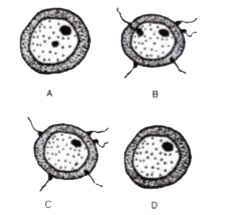How is the process of fertilisation completed in plants?
Step-by-Step Solution:
1. Pollination: The first step in the fertilization process in plants is pollination, which is the transfer of pollen grains from the anther (male part) to the stigma (female part) of the flower. Pollination can occur through self-pollination (within the same plant) or cross-pollination (between different plants).
2. Agents of Pollination: Various agents facilitate pollination, including wind (air), water, insects, birds, and bats. These agents help in the movement of pollen grains to the stigma.
3. Structure of Reproductive Parts: The male reproductive part of the flower is called the androsium, which consists of the anther (where pollen grains are produced) and the filament. The female reproductive part is called the gynoecium, which includes the stigma (where pollen attaches), style (which supports the stigma), and ovary (which contains the ovules).
4. Formation of Pollen Tube: Once the pollen grain lands on the stigma, it germinates and forms a pollen tube. This tube grows down through the style towards the ovary, guided by chemical signals.
5. Fertilization Process: Inside the pollen tube, there are two male gametes. The pollen tube enters the ovule through a small opening called the micropyle.
6. Syngamy: One of the male gametes fertilizes the egg cell, resulting in the formation of a zygote. This process is known as syngamy.
7. Triple Fusion: The second male gamete fuses with the two polar nuclei present in the ovule to form the endosperm, a process known as triple fusion.
8. Double Fertilization: The entire process of fertilization in plants is referred to as double fertilization because it involves two distinct fusion events: one between a male gamete and the egg (syngamy) and the other between the second male gamete and the polar nuclei (triple fusion).
9. Role of Endosperm: The endosperm formed during fertilization provides nourishment to the developing zygote, ensuring its growth into a seed.
Final Summary: The process of fertilization in plants involves pollination, the formation of a pollen tube, and two fertilization events (syngamy and triple fusion), leading to the development of a zygote and endosperm, respectively.
---
Topper's Solved these Questions
- BOOK - ICSECHAPTER - REPRODUCTION IN ORGANISMSEXERCISE - PRACTICE QUESTIONS (D)( Long Answer Type Questions) (5 Marks each)5videos
REPRODUCTION IN ORGANISMS
- BOOK - ICSECHAPTER - REPRODUCTION IN ORGANISMSEXERCISE - PREVIOUS YEAR.S BOARD PAPER QUESTIONS (A) ( Very Short Answer Type Questions) (1 mark each)9videos
REPRODUCTION IN ORGANISMS
- BOOK - ICSECHAPTER - REPRODUCTION IN ORGANISMSEXERCISE - PRACTICE QUESTIONS (B)( Short Answer Type Questions) (2 Marks each)17videos
REPRODUCTION IN ORGANISMS
- BOOK - ICSECHAPTER - QUESTION PAPER 2022 TERM 1EXERCISE - MULTIPLE CHOICE QUESTIONS45videos
QUESTION PAPER 2022 TERM 1
- BOOK - ICSECHAPTER - REPRODUCTIVE HEALTHEXERCISE - SOURCE BASED QUESTIONS23videos
REPRODUCTIVE HEALTH
Similar Questions
Knowledge Check
- Question 1 - Select One
During the process of fertilisation the pollen tube of the pollen grain usually enters the embryo sac through
AintegumentBnucellusCchalazaDmicropyle
Guttation is the process of elimination of water from plants through
View SolutionGiven below are diagrams showing the different stages in the process of fertilisation of an egg in the human female reproductive tract.
Study the diagrams and answer the questions

(i) Arrange the letters given below each diagram in a logical sequence to show the correct order in the process of fertilisation.
(ii) Where does fertilisation normally take place? What is 'Implantation' that follows fertilisation ?
(iii) Mention the chromosome number of the egg and zygote in humans.
(iv) Explain the term 'Gestation'. How long does Gestation last in humans ?
(v) Draw a neat, labelled diagram of a mature human sperm.View SolutionDouble Fertilisation
View SolutionHow do the IUDs prevent fertilisation?
View SolutionWhat is fertilisation?
View SolutionHow is digestion completed in small intestine?
View SolutionWhich of the following is a post-fertilisation event in flowering plants ?
View Solution

